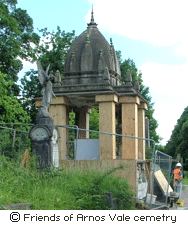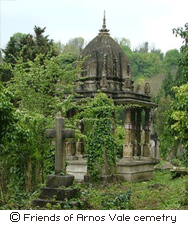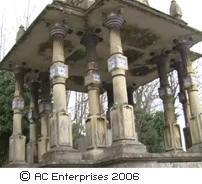 July 2 July 2
The conservation workers have found traces of gold leaf under the green paint. It is not gold paint as it is not removeable with nitromors, but actual gold leaf. Alas it is very expensive to regilde, so I have had to say clean it off along with the awful green, purple and mauve paint and leave the stonework as it must have been originally designed by William Princep. All the paints were put on in 1871, by a misguided descendent of the Rajah, who must have wanted to make the chattri look more rich and colourful. We have a photo of him standing before the painted tomb placing a huge wreath before the platform, and I found a reference to his painting works in Amal Home`s book dating from 1933, ie the commemorative volume published then by Calcutta University.
 I have also made sure that the present flaking limewash under the dome and all round the platform base of the tomb is cleaned off entirely, and the original stonework revealed. It should never have been thus limewashed, but alas it was in the early 1980s. Some grand Mughul tombs were occasionally painted to make them look as if they were built of marble - but only when viewed from a distance! I am sure that "our" tomb would not have been thus painted since it was designed to be seen close to from the pathway which passes immediately before it- within touching distance in fact. Our architect advised against a complete clean of the entire tomb as this removes some of the stonecarving detail and exposes the underlying stone to the elements. Thus the platform of the chattri will look cleaner than the dome when all is finished. I have also made sure that the present flaking limewash under the dome and all round the platform base of the tomb is cleaned off entirely, and the original stonework revealed. It should never have been thus limewashed, but alas it was in the early 1980s. Some grand Mughul tombs were occasionally painted to make them look as if they were built of marble - but only when viewed from a distance! I am sure that "our" tomb would not have been thus painted since it was designed to be seen close to from the pathway which passes immediately before it- within touching distance in fact. Our architect advised against a complete clean of the entire tomb as this removes some of the stonecarving detail and exposes the underlying stone to the elements. Thus the platform of the chattri will look cleaner than the dome when all is finished.
All of the stone finials on the lower and  upper levels of the tomb had broken off over time, and needed to be replaced. Fortunately I have the 1871 photo and another in a 1986 book by an English architect, Raymond Head, on "The Indian Style", which show clearly what the original finials looked like. They are now all being copied in the same sand stone and replaced on their pinacles. The very top finial is made of iron and had rusted badly. I have suggested that it be replaced by a stainless steel tip to the shikara, this rises out of a beautifully carved open lotus which will be cleaned too. It has been a heavy responsibility to alone suggest what should be done or indeed not done to the chattri. I have been helped by 2 local architects and have read many Indian published books myself on the subject of chattris and such monuments. Of coure all this presupposes that William Princep followed such designs faithfully when he drew up the plans in 1842 for the tomb here. It appears correct in all details to us here- all that is except the sarcopohus which rises on top of the platform and which carries the epitaphs. This is European in feel and design. upper levels of the tomb had broken off over time, and needed to be replaced. Fortunately I have the 1871 photo and another in a 1986 book by an English architect, Raymond Head, on "The Indian Style", which show clearly what the original finials looked like. They are now all being copied in the same sand stone and replaced on their pinacles. The very top finial is made of iron and had rusted badly. I have suggested that it be replaced by a stainless steel tip to the shikara, this rises out of a beautifully carved open lotus which will be cleaned too. It has been a heavy responsibility to alone suggest what should be done or indeed not done to the chattri. I have been helped by 2 local architects and have read many Indian published books myself on the subject of chattris and such monuments. Of coure all this presupposes that William Princep followed such designs faithfully when he drew up the plans in 1842 for the tomb here. It appears correct in all details to us here- all that is except the sarcopohus which rises on top of the platform and which carries the epitaphs. This is European in feel and design.
I have not managed to get these two epitaphs switched round as I had hoped. The one on the back of the chattri is really the original one and carries Dwarkanath Tagore`s wording. The present overwordy front one was put there by a Mr. Chatterji in 1871 - the same man who had the chattri painted. I hope that this change will be effected later on, we cannot do it now as we need the permission of the English Heritage body (similar to your INTACH) to alter anything on a listed building- and this tomb is Grade 2*, a very high listing indeed.
Indeed all we have done in this repair and conservation job on the tomb has been subject to rigid inspection and control, everything has had to be done in original and correct material,(except the top finial) to restore the chattri to its original condition ,size and shape as far as possible.
 All the broken stonework on the platform and the dome will be recut out of the same or similar sandstone and replaced. The base of the platform has been stabilised, and the stones rejointed and sealed so the cracks in the platform have gone. Also the rusted rods inside the pillars are being removed and replaced with stainless steel rods, which will last and not cause the carved pillars to split again. The stone casing around the pillars has had to be recut and replaced of course as it was so badly split and cracked. All the broken stonework on the platform and the dome will be recut out of the same or similar sandstone and replaced. The base of the platform has been stabilised, and the stones rejointed and sealed so the cracks in the platform have gone. Also the rusted rods inside the pillars are being removed and replaced with stainless steel rods, which will last and not cause the carved pillars to split again. The stone casing around the pillars has had to be recut and replaced of course as it was so badly split and cracked.
I pray that our present work will last well, and so ensure that this most important monument to the Rajah will last for generations to come. The tomb should be a source of great pride for all Indians here and in India,as well as a monument of rare and great beauty to all who come to see it in Bristol.
July 25
The repairs to the tomb are pretty well finished now. I have just returned from the cemetery , where I have spent much time over the last 2 months watching how matters were progressing.
Most of the scaffolding has been removed, since the pillars with their new steel insides have been put back in place. All the stone finials have been recut and replaced along with some stone replacements here and there.A lot of the purple and green paint has been removed, and this has been a difficult task as it had an undercoat to bond it to the sandstone.The rest will go this week. The white paint on the underside of the dome and all round the base of the platform is proving equally difficult to remove, but I have insisted that it must go, to leave the chattri in its original condition. Apparently about 5 days more work is to be carried out to complete the whole restoration, but the work has taken far longer than anticipated. It should have been finished by 19th July but will now hopefully be done by the 1st week of August.
|